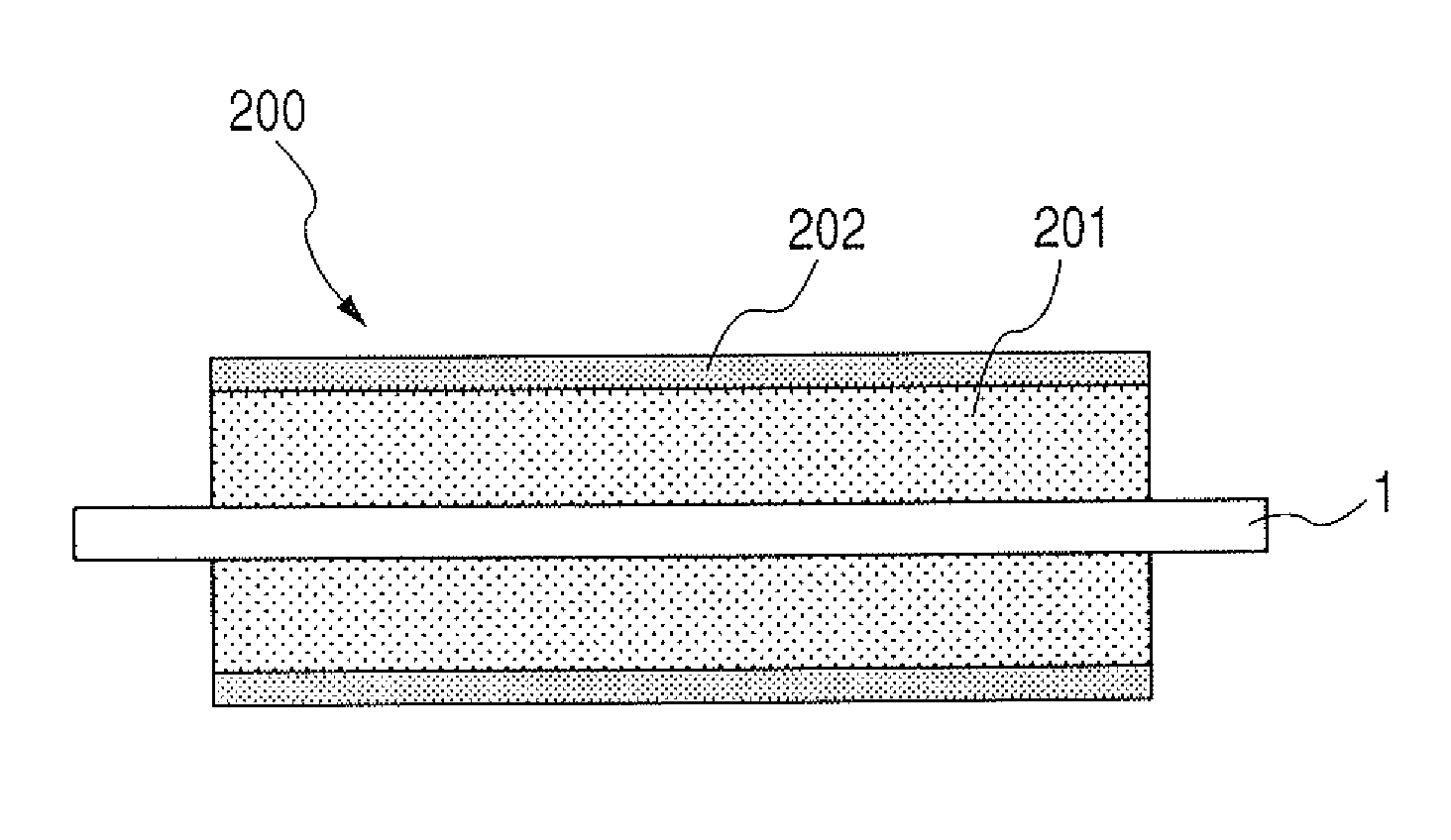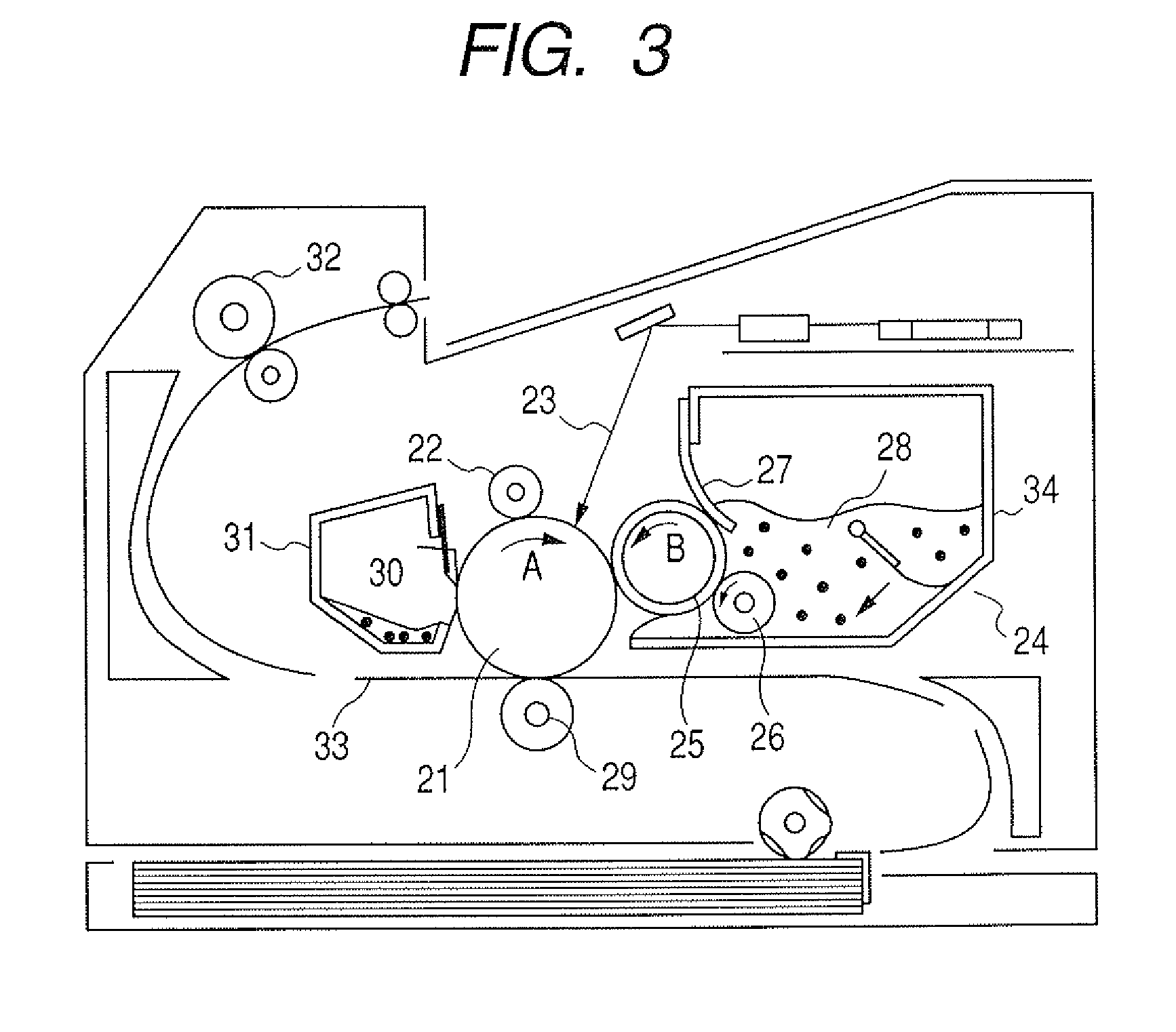Developing member and electrophotographic image forming apparatus
a technology of developing member and electrophotographic image, which is applied in the direction of electrographic process, application, instruments, etc., can solve the problems of prone to fogging and insufficient prevention of fogging in high temperature and high humidity environment, and achieve the effect of high reliability
- Summary
- Abstract
- Description
- Claims
- Application Information
AI Technical Summary
Benefits of technology
Problems solved by technology
Method used
Image
Examples
example 1
[0106]A core bar (mandrel) with an outside diameter of 8 mm was installed in a cylindrical die with an inside diameter of 16 mm so as to be concentrically arranged with the die. Subsequently, a liquid conductive silicone rubber (manufactured by Dow Corning Toray Silicone Co., Ltd., an ASKER-C hardness of 40°, and a volume resistivity of 1×107 Ω·cm) was injected as a material for forming an elastic layer into the cylindrical die. After that, it was placed in an oven at 130° C. and then heated and molded for 20 minutes. After removing the molded product from the die, secondary vulcanization was carried out in an oven at 200° C. for 4 hours, thereby forming an elastic layer with a thickness of 4 mm on the periphery of the core bar.
[0107]Next, the following materials were mixed stepwise in a methyl ethyl ketone solvent and allowed to react with each other at 80° C. for 3 hours under a nitrogen atmosphere. Consequently, a polyether polyol prepolymer (1) with a weight-average molecular we...
example 2
[0115]A core bar covered with an elastic layer was prepared in the same manner as in Example 1.
[0116]A coating fluid for forming a resin layer was prepared as follows.
[0117]First, the following materials were mixed stepwise in a methyl ethyl ketone solvent and then allowed to react with each other at 80° C. for 3 hours under a nitrogen atmosphere. Consequently, a polyether polyol prepolymer (2) with a weight-average molecular weight Mw of 6,800 and a hydroxyl value of 43 was obtained.[0118]Polytetramethylene glycol (trade name: PTG650SN, manufactured by Hodogaya Chemical Co., Ltd.): 100 parts by mass[0119]Trimethylol propane (manufactured by Mitsubishi Gas Chemical Company, INC): 3 parts by mass[0120]Isophorone diisocyanate (manufactured by Aldrich Co., Ltd.): 30 parts by mass
[0121]Next, the following raw materials were mixed and methyl ethyl ketone was then added so as to be in a solid content of 28% by mass. The resulting product was used as a raw material liquid for the formation...
example 3
[0127]A developing roller of Example 3 was produced in the same manner as in Example 2 except that the non-reactive silicone compound No. 2, which was used for preparing the coating fluid for forming the resin layer as the outermost layer, was replaced with the non-reactive silicone compound No. 3; and the mixing amount thereof was changed to 0.5 parts by mass.
PUM
| Property | Measurement | Unit |
|---|---|---|
| relative humidity | aaaaa | aaaaa |
| temperature | aaaaa | aaaaa |
| temperature | aaaaa | aaaaa |
Abstract
Description
Claims
Application Information
 Login to View More
Login to View More - R&D
- Intellectual Property
- Life Sciences
- Materials
- Tech Scout
- Unparalleled Data Quality
- Higher Quality Content
- 60% Fewer Hallucinations
Browse by: Latest US Patents, China's latest patents, Technical Efficacy Thesaurus, Application Domain, Technology Topic, Popular Technical Reports.
© 2025 PatSnap. All rights reserved.Legal|Privacy policy|Modern Slavery Act Transparency Statement|Sitemap|About US| Contact US: help@patsnap.com



